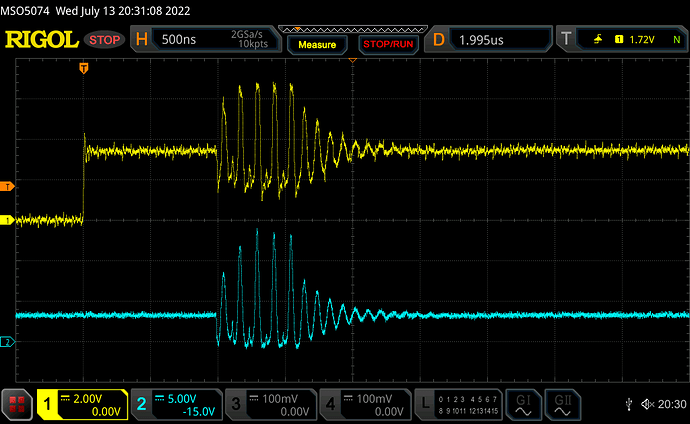These days, I’m experimenting with the various functions of the Chipwhisperer lite using a BluePill STM32F103C8 as a target board. I purposely wanted to use a real board to be able to deal with real problems. I must say that I am a bit demoralized, I tried to use PicoEMP to generate EMP faults but without success, I then tried to use clock glitch and also in this case no result, finally I tried power fault injection (LP, HP and LP + HP) and even in this case no results (I also removed all the capacitors present in the board to remove any possible doubt). I have created a simple c code that does nothing but count and print the various results on the screen but strangely the board seems to be immune to all attempts at attack. Using a RIGOL MSO5074 I verified that the settings made on the Chipwhisperer were correct so I am sure that the various attacks were performed as I expected.
I have attached a screenshot of a power glitch, the board is without capacitors, the strange thinks are the 15V measured after any glitch. Is it normal as behavior ? Is also normal that glitch is generated after 8 clock cycles from trigger (ext_offset on all tests is set to 0) ?
The following is the C code in the target board. With any attack i,n,j,k are not affected!
Anyone have any ideas or suggestions? Is there something I’m doing wrong?
digitalWrite(LED_BUILTIN, ON); // Turn the LED ON
digitalWrite(PC14, HIGH); // Io for extrnal trigger
k = 0;
n++;
for (i=0; i<1000; i++)
{
for(j=0; j<1000; j++)
{
k++;
}
}
digitalWrite(PC14, LOW);
SerialUSB.printf("%d] I=%d J=%d K=%d\n", n, i, j, k);
digitalWrite(LED_BUILTIN, OFF);
The following is the python code of Voltage glitching
import chipwhisperer as cw
import time
scope = cw.scope(scope_type=cw.scopes.OpenADC)
print("Firmware version : " + str(scope.fw_version['major']) + "." + str(scope.fw_version['minor']))
print("Serial number : " + bytes.fromhex(scope.sn).decode('ASCII'))
scope.io.glitch_hp = False
scope.io.glitch_lp = False
scope.adc.basic_mode = "rising_edge"
scope.io.hs2 = "clkgen" # output glitch_out on the clock line
scope.clock.clkgen_freq = 8E6
scope.glitch.clk_src = "clkgen"
scope.glitch.trigger_src = "ext_continuous"
scope.glitch.output = "glitch_only"
scope.glitch.offset = 1
scope.glitch.width = 15
scope.glitch.repeat = 5
scope.glitch.ext_offset = 0
scope.trigger.triggers = "TIO4"
print(scope.glitch)
input("Press Enter to continue...")
scope.io.glitch_lp = True
scope.io.glitch_hp = True
input("Press Enter to continue...")
scope.io.glitch_lp = False
scope.io.glitch_hp = False
scope.dis()
